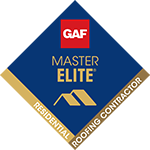How Wind & Hail Damage Roofs: What Connecticut Property Owners Need to Know

- Wind damage on pitched shingle roofs
- Wind damage on low-slope (commercial/HOA) roofs
- How hail “reads” differently
- Why water is smarter than we think
- Connecticut storms: recent pattern
- Post-storm action plan (owners & facility managers)
- FAQ
Severe storms are a fact of life in Connecticut and across New England. From powerful wind gusts to damaging hail, your roof is the first line of defense for your home or building. Understanding how wind and hail actually damage pitched shingle roofs and low-slope commercial roofs helps you prevent costly repairs and protect your property investment.
How Wind Damages Pitched Shingle Roofs (Residential & Small Multi-Family)
High winds don’t just “blow shingles off.” The real culprit is uplift at edges and ridges. Wind gets under shingle tabs, exploiting any weakness in nailing or the adhesive strip. Repeated gusts fatigue the bond until lift-off.
Common failure modes
- Tab creases and lifted tabs
- Missing shingles
- Ridge vent displacement
- Exposed nails leading to leaks later
Prevention on steep-slope roofs
- Correct nail placement per manufacturer specs
- Upgraded underlayments in high-exposure zones
- Re-seal compromised tabs after severe wind
How Wind Damages Low-Slope Roofs (Commercial, HOA, Multifamily)
On low-slope systems, perimeter and corner zones take the beating. High uplift loads concentrate there; if edge metal or perimeter attachment is weak, wind can peel back large roof sections.
FM Global calls perimeter edge flashing the most important roof component for wind resilience. Match fasteners and spacing at perimeters/corners to the building’s wind zone (FM, IIBEC).
How Hail “Reads” Differently
On shingles
- Granule loss and substrate bruising shorten service life
- Leaks may not appear for months
On membranes (TPO, EPDM, PVC)
- Surface fractures and punctures—often near drains and parapets
- Crushed insulation lowers R-value
- Infrared scans can reveal latent moisture after a storm
Why Water Is Smarter Than We Think
Wind and hail may start the damage, but water finishes the job.
- Pitched roofs: Wind-driven rain intrudes at flashing and ridge/valley transitions.
- Low-slope roofs: Any ponding water lasting >48 hours magnifies defects and can void certain warranties—design and maintenance must ensure positive drainage.
CT Tie-In: Recent Storms Prove the Pattern
Late-July 2025 storms brought damaging winds and hail to multiple Connecticut towns with thousands of outages—classic conditions for edge, seam, and shingle failures. Local coverage documented widespread impacts, reinforcing the need for perimeter-first inspections.
Action Plan (Owners & Facility Managers)
- Schedule a perimeter-first inspection (edges, corners, penetrations).
- Document everything: photos + a roofer’s written report—especially if an insurer leans on aerial images instead of a physical inspection.
- Know your rights in CT: Cosmetic streaking isn’t grounds for nonrenewal; carriers should verify material degradation.
- For partial replacements that won’t match: Cite Connecticut’s matching statute (CGS §38a-316e) to require a reasonably uniform appearance.
Protect Your Roof – Protect Your Property
Whether you own a home in Hartford or manage a facility in New Haven, wind and hail don’t wait—and neither should you. We provide comprehensive inspections, storm-damage repair, and insurance claim support across Connecticut.
Heritage Systems Inc. / Millstream Construction
Frequently Asked Questions
How do I know if wind uplift damaged my shingles? Look for creased tabs, missing shingles, and displaced ridge vents. If nails are exposed, water entry is likely—schedule an inspection. Where should we check first on a commercial roof after a storm? Start at perimeters and corners, then check edge metal, seams, and penetrations. These zones see the highest uplift. Can hail damage be “invisible” at first? Yes. Shingles can have bruising and membranes can have micro-fractures. Infrared moisture scans help reveal hidden damage. What counts as “matching” in Connecticut? Under CGS §38a-316e, replacements should result in a reasonably uniform appearance. If a partial repair won’t match, you can request broader replacement.© 2025 Heritage Systems Inc. / Millstream Construction • All rights reserved.
Subscribe to Millstream Construction's Blog







Comments